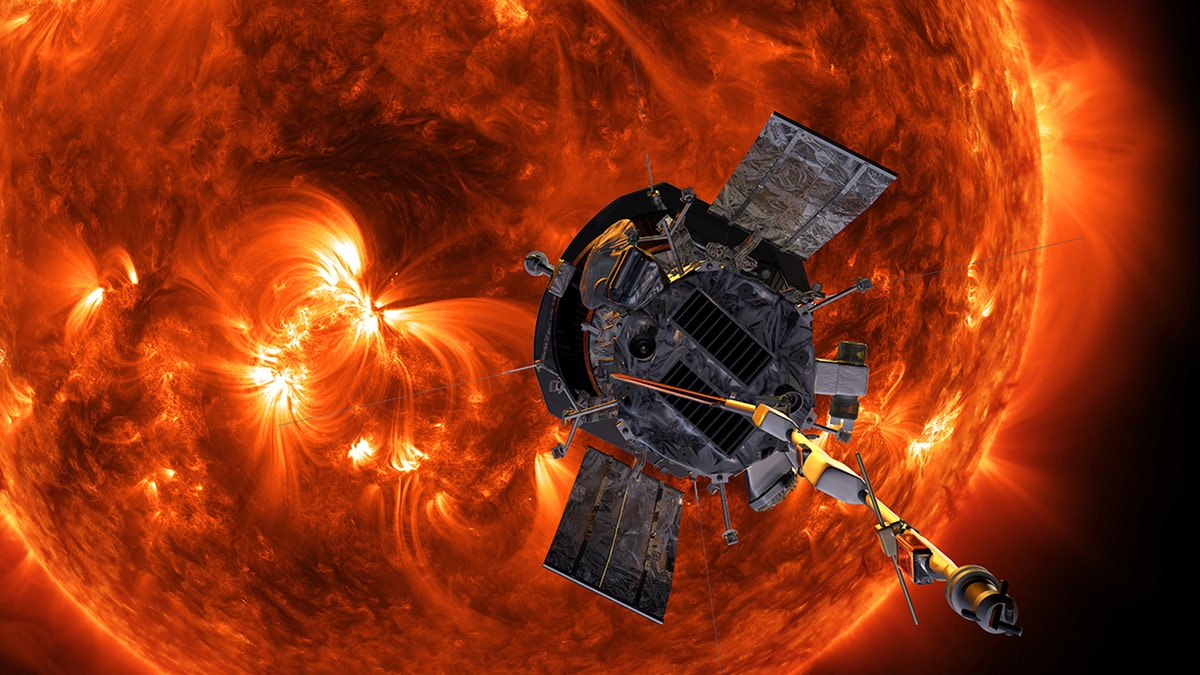
(Credit: NASA)
Luckily, this wasn't a close encounter of the burned kind.
After becoming the closest spacecraft to the Sun last month, NASA's Parker Solar Probe has gotten even closer, coming within 15 million miles of our solar system's star on its own, a feat NASA has called a success.
On Monday, Nov. 5, the spacecraft whizzed past the Sun and on Wednesday, Nov. 7, it called home to let its creators know everything is in working order and it's collecting data as it should be.
END OF DAY'S TELESCOPE IMAGES REVEAL WHAT HAPPENS WHEN GALAXIES COLLIDE
“Parker Solar Probe was designed to take care of itself and its precious payload during this close approach, with no control from us on Earth — and now we know it succeeded,” said Thomas Zurbuchen, associate administrator of NASA’s Science Mission Directorate at the agency headquarters in Washington in a statement.

Members of the Parker Solar Probe mission team celebrate on Nov. 7, 2018, after receiving a beacon indicating the spacecraft is in good health following its first perihelion. (Credit: NASA/Johns Hopkins APL/Ed Whitman)
Zurbuchen continued: “Parker is the culmination of six decades of scientific progress. Now, we have realized humanity’s first close visit to our star, which will have implications not just here on Earth, but for a deeper understanding of our universe.”
In addition to coming closer to the Sun than any other man-made spacecraft and letting us know it's in good working condition, the Probe also set a speed record, NASA added. At its closest approach, known as a perihelion, the Parker Solar Probe reached a top speed of 213,200 mph.
"Along with new records for the closest approach to the Sun, Parker Solar Probe will repeatedly break its own speed record as its orbit draws closer to the star and the spacecraft travels faster and faster at perihelion," the government space agency wrote in the release.
The Parker Solar Probe will make its last close approach to the Sun in 2025, where it will come within 3.83 million miles of the star's surface. This is seven times closer than the previous closest spacecraft, Helios 2, which came within 27 million miles of the Sun in 1976.
NASA'S PARKER SOLAR PROBE SNAPS EARTH PIC AS IT SPEEDS TO THE SUN
Aided by the Sun's own gravity, the Probe will fly at an unbelievable 430,000 mph, NASA has said previously. By comparison purposes, the speed of sound is approximately 761 mph and the speed of light is 670,616,629 mph.
The $1.5 billion mission launched on Aug. 12 and was taken into orbit by a United Launch Alliance Delta IV Heavy rocket.
Parker must withstand heat of nearly 2,500 degrees Fahrenheit to complete its audacious mission. To achieve this, the probe will be protected by a special 4.5-inch-thick carbon-composite shield. Safe inside the spacecraft, however, the probe’s payload will be operating at room temperature, generally kept in the mid-80s Fahrenheit, NASA said.
CREEPY ORANGE 'AIRGLOW' SURROUNDS THE EARTH
The Sun’s corona, which can be seen during a total solar eclipse, is usually hidden by the bright light of the star’s surface. The Probe, named after pioneering solar physicist Dr. Eugene Parker, will provide a wealth of invaluable data.
Scientists expect to shed new light on the Sun’s potential to disrupt satellites and spacecraft, as well as electronics and communications on Earth.
It is also hoped that the Probe will provide answers to what scientists describe as “the coronal heating problem.” One of the most unusual aspects of the Sun is that its atmosphere gets much hotter the farther it stretches from the star’s surface, according to NASA.
Fox News' James Rogers contributed to this report. Follow Chris Ciaccia on Twitter @Chris_Ciaccia
